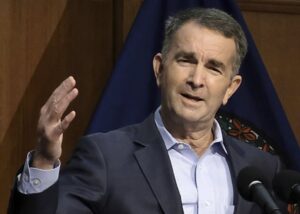by James C. Sherlock

Governor Ralph Northam has raised an important issue relative to the budget negotiations. He has asked that the final bill not include an extension of a 12.5% increase in rates for Medicaid home- and community-based services for people with developmental and intellectual disabilities. The General Assembly put it in there anyway.
That amendment, submitted by Sen. Emmett Hanger, R-Mount Solon, extends the expiration date for the increases from the end of calendar year 2021 to the end of the fiscal year on June 30, 2022. Hanger’s amendment claims that:
“The costs of extending the rates are covered by the state savings in Medicaid from the 12 months of enhanced federal match for Medicaid Home and Community-based services included in the American Rescue Plan Act of 2021.”
That is a budget offset of “free” money from federal taxes and the deficit, but not defense of the program itself.
The governor must have a good reason to have not only left that money out of the supplemental budget bill, but also to ask the General Assembly to take it out.
I’ll offer some thoughts on why he likely did so.
The governor’s liberal credentials and those of his appointees are hardly in doubt. The fact that they want answers to questions that they do not have in hand suggest they harbor significant doubts about patient results from the increases.
Especially because it would be politically easier to go along.
Questions
Financial questions:
- How much money is involved? Were there savings in Medicaid from less institutionalization?
- What are the terms and longevity of the extension?
- Was there a shortage of providers before the increase that was mitigated by the extra money?
- Is there a shortage now that could be exacerbated by a cut?
Policy questions:
- Did the extra payments to home- and community-based providers result in fewer patients institutionalized?
- Did we see a downward or upward trend in hospitalization for non-COVID causes of patients in home- and community-based care? How did the direction and slope of that curve compare to that for institutionalized patients?
- The state’s ability to inspect healthcare facilities and providers was compromised by chronic staff shortages long before COVID. Did the new money draw new providers about whom there may be questions and for whom the state lacks inspection capacity?
- Did the payments increases produce better outcomes for the patients? Worse?
- Were patients surveyed before and after the increase to gauge a change in patient satisfaction?
Answers
The dollar cost of the budget line item is certainly known. The answers to questions about the effects of the extra money on the supply of providers are discoverable if not already known.
Clearly, however, the governor doesn’t know whether the higher payments increased the health and well being of patients. And it clearly bothers him.
In the healthcare community such questions are featured in what is called a “patient-centered” approach. The answers to those policy questions are the difference between an effective healthcare measure and a mistake, whatever may be the costs or savings involved.
The governor wants those answers in a package on his desk before he supports the budget increase.
Good for him. I support him. So should we all.


